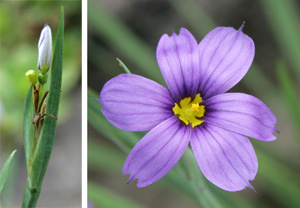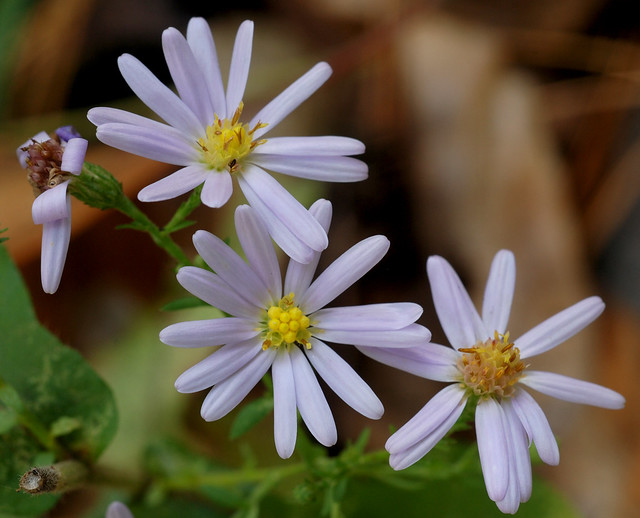
Orchids come in a variety of shapes, sizes, and colors, and are considered the most highly evolved of plants. They typically have showy, three-petaled flowers with the middle petal (the lip) differing in shape and color.
Some plants flourish only in a very specific set of conditions or habitats. In ecological terms, these species are called specialists, whereas those that grow in a wide range of ecological conditions are called generalists. Exemplifying the specialists is the Pink Lady’s Slipper. This hardy native orchid flourishes only in semi-open woodlands in deep humus and acidic, but well-drained soil, and even there it requires the presence in the soil of a particular fungus from the Rhizoctonia genus to survive. Generally, orchid seeds do not have stored food inside them like most other kinds of seeds. Orchid seeds require threads of the fungus to break open the seed and attach them to it. The fungus will pass on food and nutrients to the orchid seed. When the orchid plant is older and producing most of its own nutrients, the fungus will extract nutrients from the orchid roots. This mutually beneficial relationship between the orchid and the fungus is known as symbiosis and is typical of almost all orchid species.
This is the first of a 3-part series of articles about the orchids I’ve observed on area trails. Part 2 will appear in three weekly installments beginning in early July and the finale will be posted in late August. Each will feature the orchids that are in bloom at that time.
Today, I’m featuring Pink Lady’s Slipper (Cypripedium acaule) as one of our orchids that begins to bloom at this time.


PLEASE NOTE: New York Protected Status: Exploitably Vulnerable = Native plants likely to become threatened in the near future throughout all or a significant portion of their ranges within the State if causal factors continue unchecked. Fragmentation of remaining habitat, contamination of the gene pool, and wild harvesting present ongoing threats to this species.
The genus name Cypripedium is from the Greek, “Kypris”, a name for Venus; and “pedion”, also Greek, for an anklet, instep, or having to do with the foot. Presumably then, Cypripedium translates as Venus’ Slipper. The species name acaule, meaning stemless, refers to the pair of opposite stemless leaves at the base of the plant. Another common name for this plant is Moccasin Flower.
Pink Lady’s Slipper is one of the largest native orchids in the United States. Once it has germinated, it may take more than a decade before a plant first blooms (Curtis, John T. 1943. Germination and seedling development in five species of Cypripedium L. American Journal of Botany 30: 199-206). Thereafter, they don’t bloom every year and most plants will produce seeds only four or five times over their lifespan, which averages between 20-25 years. In between blooming, they’ll remain dormant in the soil, gathering resources until they are ready to bloom again.
Description:

Pink Lady’s Slipper is a long-lived perennial herbaceous plant up to 16” tall with two opposite toothless basal leaves that are 3½ to 9 inches long and 1 to 3½ inches wide with conspicuous parallel veins.

https://www.minnesotawildflowers.info/flower/stemless-ladys-slipper#lboxg-2
Its showy flower is a single large bloom atop an erect hairy stalk along with a couple of green or copperish-brown sepals and petals, but no leaves.

The flower is magenta to whitish-pink; sometimes the whitish pink flowers will have darker pink venation. Rarely the flower may be all white. Lady’s Slipper orchids have three petals, one that forms the ‘slipper’, while the other two are shaped like slightly curly ribbons or ties, positioned just above the slipper. Unlike most other species of this genus, the pouch of this flower opens in a slit with inwardly rolled edges that runs down the front of this flower, rather than as a round opening.

https://www.minnesotawildflowers.info/flower/stemless-ladys-slipper#lboxg-3
The fruit is an ascending capsule that ripens to brown and contains thousands of tiny seeds.

Photo Credit: Mary Anne Borge,
https://the-natural-web.org/2021/06/06/pink-ladys-slipper-so-lovely-so-deceptive/
Folklore:
An old Ojibwe legend tells of a village visited by plague. It was the dead of winter and many died, including the village healer. To save the community, a young girl made a dangerous journey through the snow to find medicine for the sick. She succeeded, but on the way lost her moccasins, leaving a trail of bloody footprints in the snow. When spring arrived, the bloody footprints put forth moccasin flowers.
Pink Lady’s Slipper has been used in sachets to protect against and ward off hexes, curses, spells and the evil eye.
Wildlife Value:
Pink Lady’s Slippers require bumble bees for pollination, including American Bumble Bee (Bombus pensylvanicus), Ashton’s Cuckoo Bumble Bee (Bombus ashtoni), Common Eastern Bumble Bee (Bombus impatiens), Flavid Cuckoo Bumble Bee (Bombus fernaldae), Half-black Bumble Bee (Bombus vagans), and Northern Amber Bumble Bee (Bombus borealis).
Bees are lured into the flower pouch through the front slit, attracted by the flower’s bright color and sweet scent.

https://www.nature.org/en-us/magazine/magazine-articles/secret-garden-orchids/
Once inside, the bees find no reward, and discover that they are trapped, with only one point of escape. Inside the pouch, there are hairs that lead to a pair of exit openings, one beneath each pollen mass. The bee must pass under the stigma, so if it bears any pollen from a visit to another flower, it will be deposited before picking up a fresh load on the way out.
Bees quickly learn from this experience and soon avoid repeat visits to these flowers, which accounts for low pollination rates for this orchid. To wit, a University of Maryland botanist studied a few thousand Pink Lady’s Slippers in a national forest and found that, over 16 years, about 1/3 of them flowered. Of those, a mere 23 were successfully pollinated! However, once pollinated, each successful flower will produce tens of thousands of seeds.
Where Found Locally:
Pink Lady’s Slipper requires highly acidic soil but tolerates a range of shade and moisture. As such, it is usually found under partial shade in pine forests, where it can sometimes be seen in large colonies, but it also grows in deciduous woods.
- 100 Acre Wood
- Ann Lee Pond Nature and Historic Preserve
- Bauer Environmental Park
- Dwaas Kill Nature Preserve
- Ushers Road State Forest
For more information about all of New York’s orchids, please view Orchids of New York and Orchids of New York State.











































